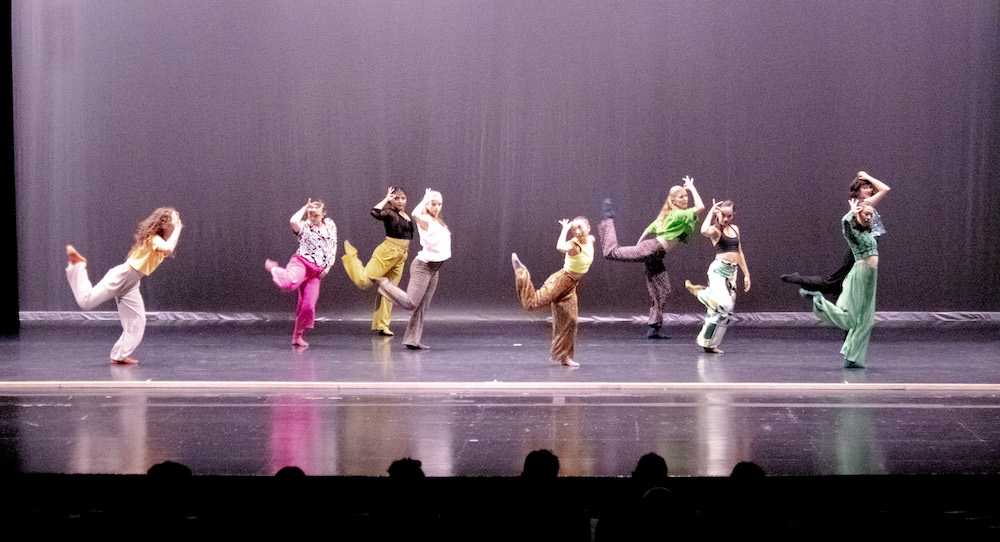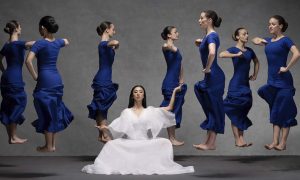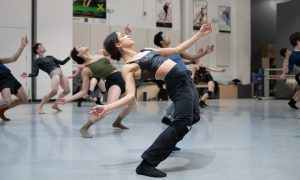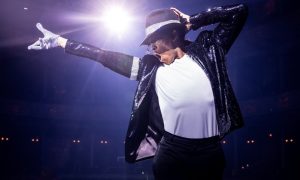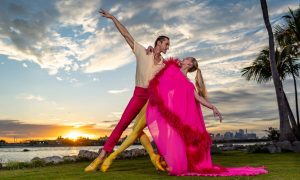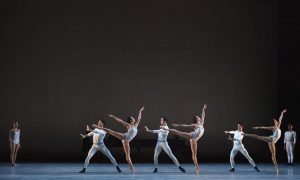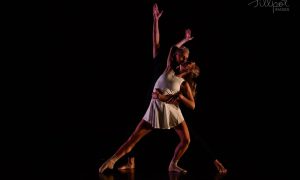Hope High School, Providence, RI.
August 24, 2025.
As a critic, sometimes I read program notes before the show, sometimes I don’t. Sometimes I want to receive the works with no prior context, and then see how that experience changes when I later learn more about them. Sometimes I want to come in with full context.
I thought about this question – of experiencing dance with or without context – when viewing the Choreography Project‘s New Beginnings. With many of the works, I saw not a full painting of the theme that the choreographer described in program notes and their curtain speech (which each gave before their work was presented).
Instead, I perceived something a bit more abstract and intriguingly hazy in those thematic directions – for me, inspiring curiosity and questions about how the works could evolve (should they do so for further iterations). Each choreographer had the courage to explore something fresh, bold, meaningful – and that, in and of itself, is to be applauded.
There were interesting curiosities there, but what was not in question: the performance and design excellence, the thoughtfulness and intentionality of dancers and collaborators in each step, costume, lighting cue, et cetera. The project is under Executive Director Kristy DuBois, with Devin Mooney serving as Technical Director.
Shannon Mullaney’s Four’s A Crowd explored the positive and negative dynamics within a group setting, and the consideration therefore requisite with “the company you keep.” Musicality was satisfying, and formations crisp. Movement was light and effervescent, and the ensemble’s fluid, colorful dresses complemented that quality.
Quick bourrées led them to a wide second position, and one ankle crossed before the other: the opening and closing inherent in human relating. Sweet little moments painted a picture of true visceral connection; dancers tenderly lay heads on another’s back.
There were moments of rising tension – through weight-sharing, momentum, and gaze – yet the atmosphere remained mostly jovial, light-hearted (and beautifully so). I didn’t see or feel as much of the cautionary tale that Mullaney noted, the potential pitfalls in group dynamics. Yet, I savored the sweetness of what was there, as well as appreciated the additional layers that this piece could accumulate should it continue from here.
Dara Nicole Capley’s enticing and enigmatic Strange Attractors (The Lovers) held a magnifying glass to the mysteries of attraction. She even prompted audience members to think on these mysteries in her curtain speech, before a step of the work transpired. One performer in heels and a sparkly little black dress entered to roll out a large white carpet, and then entered our protagonist couple: Marcel Santiago and Katherine Vigly.
Reaching arms, rolling hips, popping heels, they came together and apart – attracting and repelling. Certain gestures and theatrical choices, not to mention the score (“You Wanted a Hit” by LCD Soundsystem), applied notable touches of quirkiness. That’s not something I’d expect from the theme, but I do like being surprised. Superb musicality had them hitting and riding beats of the techno score: a confluence of sharp and smooth.
Sudden red lighting brought a structural shift – and that’s when the red paint also showed up. Originating in their rolled-out white floor, it was soon all over both of them. I wasn’t exactly sure of the choice’s intent – it did bring to mind for me absurdist horror (à la Kill Bill). Many artists would portray this theme with sensuality, perhaps even tenderness – but Capley brought something wholly different. I commend that boldness, and also appreciated the stellar movement on offer.
Hannah Franz’s Nightlight kinetically probed the conflicting desires for privacy and anonymity and those to be seen and understood. With choral voices in the soundscape, dancers in silhouette built movement from stillness to thrashing. The group fell away, and one dancer continued. With notably honest theatricality, she found vitality and possibility away from the structure of the former group.
Another group section presented particularly keen kinetic attunement. These explorations both humanized the dancer and pushed athletic limits: a skillful balancing and integrating of the two approaches. A more somber solo began to wind the work down to its end. The dancer stepped delicately – as if afraid that she might break something. The meeting of the personal and communal is a tenuous one indeed.
A partner joined, their movement then finding additional torque and multifaceted gesture. The larger group subsequently joined, adding rhythmic footwork of a more unified feel. Gestures softened, adding ease and care to that group strength. Thus, the work ended with another beautiful balance, one of tenderness and ferocity. In that can be care for both self and other, for the shared and kept to one’s own.
After a pause came Nina Yoshida-Webster’s Technopology, astutely depicting another kind of tension: that between connection and isolation within technology use. The work began as a solo, and that dancer remained highlighted as group sections developed – interacting with them in both harmonious and more agitated ways.
Electronica beats and metallic sparkles on the backdrop aesthetically framed these movement interactions, setting them in a technological context. Dancers weaved fluid spatial patterns, yet also those with rough edges; technology facilitates, yet also presents its own obstacles. The individual dancing alone again, graceful spirals nevertheless took on some of the score’s tense phrasing – the electronic always having its impact.
The work ended with the group again: at times lifting and echoing, at other times confining the individual. Technology can and does have all these varied impacts on us. I also wondered about the disembodiment that technology can inflame, and if that might be something that a work like this could investigate. The work ignited my curiosity beyond the fascinating exploration that it did present!
Deanna Gerde’s Is It Enough? followed, a sensitively constructed and joyful painting in movement. Spotlight came up on a slowly moving group, acutely attuned to each visceral nuance. As they accumulated speed, tempo, and size in their movement, they built an upbeat, vibrant atmosphere that also offered a dash of edginess – like a spice that enhances a sweet treat. Their colorful costumes, all in individual styles, aligned with that very same blend.
Alternating levels, as well as partners assisting the continued channeling of each other’s momentum, helped keep that vibrancy alive and well. A trio began to wind the work’s energy down, with the ease and calm of a summer picnic. Dancers entered and exited along with ringing phones and tones in the music, as if summoned elsewhere. Even if we might be, the ebullience – yes, also peppered with the spice of our own individuality – can continue.
Ava Grebe’s Fond delicately and thoughtfully portrayed the sentimental and nostalgic qualities we associate with certain objects. It began with the ensemble looking in a box, smiles indicating the happiness that treasured objects can bring. Heads rolled to initiate movement, which soon took up more stage space – the group expanding beyond this small locus of sentimentality.
A feeling of pleasing synchronicity in the movement echoed the easy joy of nostalgia. A variety of qualities – accent and flow, propulsion and softness, lifting and grounding – did also convey the complexity within nostalgia; it can be more than just joy. After all, memory can bring a flood of varied thoughts and feelings.
The work escalated to movement of greater size, precision, and sense of unity amongst the personas. Memory also can, at times, be sweetest and strongest when experienced together. The work then closed with a poignant moment of holding a sure shape, hand-in-hand. As lights went down, I wondered if including more tangible objects in the work – things within the box, perhaps – might have made all of that even more tangible….again, my curiosity sparked from the bold exploration on hand!
Alyah Baker’s Juste, Juste traversed desire and devotion, both involved with romance but two separate paths within that…or are they? Movement pathways were exhilarating, bringing dancers to and away from each other – just as in Capley’s work, embodying the push and pull of attraction.
The ensemble wearing pointe shoes, unique to this program, added possibilities of lift and lengthening of line – those which Baker capitalized on quite well. Formations and movement through space were fluid, the group in harmony of true unspoken understanding.
Musicality matched the texture of each note, without anything feeling rushed or stuffed in for the sake of it. Soloist Nina Yoshida Webster, as always, expanded into space in a way that seemed to lengthen the very notes in the score – always a pleasure to experience.
Speaking of the score, a meditative ode to one’s love through variations on a main mantra, dancers repeated phrases just as the score repeated – building its own meditative feeling through movement. It might be easy to get caught in the sentimentality of a work like this, yet – to great effect – the dancers let the movement and all elements that supported it do the main emotional lifting. That meditative feel could then fully translate.
The score seemed to me the main reinforcement of Baker’s stated theme. Should she continue refining and/or building on this work (and I hope that she does), I’d be interested to see how she might evoke it more through the body itself, and the bodies of the ensemble as they navigate space together. What it was in this iteration, however, was both unique and calming, resonant and beautiful in its own way.
Simon Montalvo’s electric, vivacious Phenonemon closed out the work. Athleticism took the stage from the start, but not for its own sake – rather, it supported the primal feel and strong sense of group cohesion at hand. Individual thrashing funneled into more fluid unison movement. A quieter section, with a Mary Oliver poem resonating through the space, brought weight-sharing and simple leaning to signal soft care. All ways of moving and being were valid and supported: kinetically, spatially, spiritually, and beyond.
The energy rose again to round out the work, with the dancers reaching, lifting each other, undulating in that primal spirit. It was a spirit with which they graced each other…and, through their performance excellence and human honesty, also us in the audience. This felt like a great choice for a closer: raw and earthy, joyful and uplifting, touching and meaningful all at once.
Cheers to intentional choices like that, to bold themes and perhaps unconventional, unexpected ways of approaching their portrayal in movement, to open questions that could lead to exciting refinement and development. Cheers to another year’s program from this exciting project, and – whether or not those future iterations of these works await me – I eagerly await next year’s!
By Kathryn Boland of Dance Informa.
